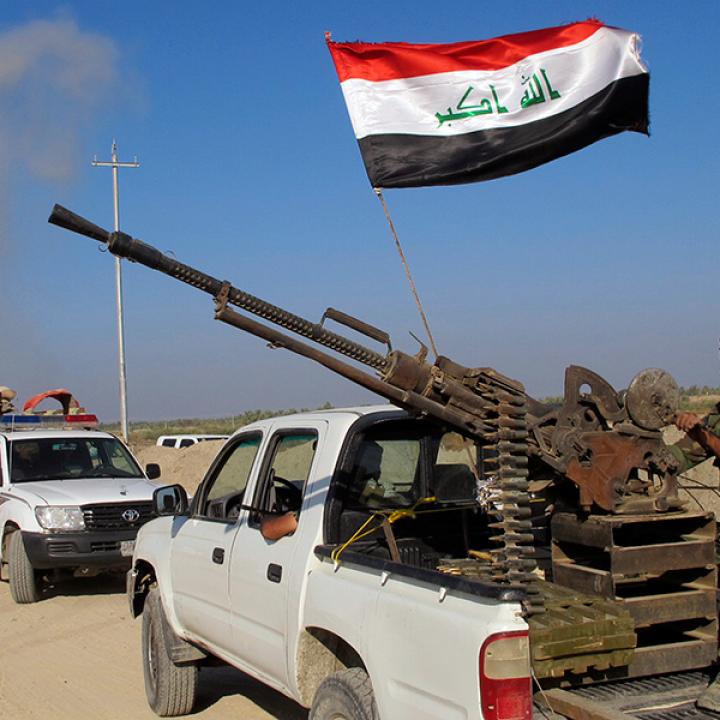
- Policy Analysis
- Articles & Op-Eds
Tehran Seeks to Consolidate Power in Iraq in 2018

Iran wants its local allies to create a Shia political bloc or Hezbollah-like arrangement next door, but Washington can curb such ambitions so long as it does not repeat its vanishing trick of 2011.
Iran's principal regional nemesis was removed when Saddam Hussein's regime was overthrown by the United States in 2003. The new Iraq quickly fell under the leadership of powerful Shia Islamist parties, most of whom had sheltered in Iran to avoid Saddam's persecution. One example is Iraqi Prime Minister Haider al-Abadi's Da'awa Party, which has produced the prime ministers that have led Iraq for twelve of the fourteen years since Saddam fell. Another major party was the Islamic Supreme Council for Iraq (ISCI), a bloc formed in Iran by the Iranian government during the Iran-Iraq War. Since ISCI and Da'awa were willing to work with the Americans, they gained advantages in the new political system, and combined with Iranian media support and political funding, they dominated the parliament, the cabinet, and provincial councils in the Shia governorates.
Some of the Shia Islamist parties were even closer to Iran. Hadi al-Ameri's Badr Organization was built as a military force by the Iranian Islamic Revolutionary Guard Corps (IRGC) to fight against Saddam in the Iran-Iraq War. After 2003, Badr placed its fighters in the new Iraqi security forces (ISF), exploiting the U.S.-led coalition's desperate need to rebuild the military. As a result, hundreds of Iranian-trained intelligence operatives were emplaced at the heart of the new U.S.-built ISF in a process known as "dimaj" (amalgamation).
Some of Badr's more extreme pro-Iranian members could not even stomach working with the U.S. for tactical benefit, and they formed so-called "special groups" that directly attacked the U.S.-led coalition after 2003. One example is Abu Mahdi al-Muhandis, a U.S.-designated global terrorist who is wanted for terrorist attacks on U.S. and Kuwaiti personnel, and for involvement in the deaths of coalition personnel in Iraq. Muhandis formed the U.S.-designated terrorist movement Kata'ib Hezbollah, which is controlled directly by the IRGC Quds Force, a U.S.-designated global terrorist entity led by the infamous General Qassem Soleimani.
But here's the kicker: Muhandis is now the operational commander of the Prime Minister's Commission of the Popular Mobilization Forces (PMF), the volunteer units raised in 2014 to fight the Islamic State (IS). He had a state budget of $1.96 billion in 2017. Hadi al-Ameri is presently, according to reputable polling, Iraq's most popular Shia leader. And another Badr leader, Qassem al-Araji, is the Minister of Interior, running Iraq's largest ministry, despite having been in an orange jumpsuit at U.S. detention facilities for 26 months during the occupation period prior to 2011, in connection with anti-U.S. attacks. Many Shia Iraqis are proud of the long record of anti-Saddam resistance activities of these men and ambivalent or supportive of actions they may have taken against the U.S. occupation. Since the victories of IS in 2014, the Iran-linked Shia militants have added to these credentials by leading the PMF on Iraqi and Syrian battlefields.
With fewer and fewer Iraqi cities under IS control, Iran has some clear objectives in Iraq in the immediate future. At minimum, Tehran wants Iraq to be run by a bloc of Shia political parties after the May 2018 Iraqi general elections, and it wants those Shia parties to work together to form the government. A Shia majority at the core of the Iraqi government gives Iran reassurance that Iraq will never again become a threat to Shia-majority Iran. What Iran doesn't want is the Shia blocs splitting their support and individually allying with Sunni Arab, Kurdish, and secular blocs to form a new kind of cross-sectarian government, which is an idea that Prime Minister Abadi and the Shia nationalist leader Moqtada al-Sadr are considering. Iran would like the U.S. military presence in Iraq to be disinvited by the next prime minister. Ideally, Iran would like to see PMF commanders like Muhandis and Hadi al-Ameri running Iraq, perhaps from behind the scenes, and cooperating fully with Lebanese Hezbollah and the Assad regime across a contiguous swathe of Iranian dominated lands running from central Asia to the Mediterranean. A senior Iraqi cabinet official once told me, "Iran is our neighbor, you cannot expect us to have an American policy towards it."
The best way to prevent this outcome is to support the forces who are trying to build Iraq as a strong independent nation, including very significant Shia partners like Abadi and Grand Ayatollah Ali Sistani, the leader of the Shia religious establishment. Though it may seem strange, Moqtada al-Sadr is one of those forces. There are Iraqi Shia leaders who want Iraq to have a neutral foreign policy, as evidenced by Abadi's and Sadr's visits to Saudi Arabia this summer, and Sistani's refusal to meet with Iranian envoys. The combination of moderate Shia, Sunnis, and Kurds is a mathematic lock to put Abadi or another moderate atop the next Iraqi government, so fixing the current mess over the Kurdish independence referendum is a priority before the Iraqi election.
The U.S. intervention against IS in the last two years has shown Iraqi leaders that there is a formula for U.S.-Iraq relations that sits comfortably between Bush's occupation and Obama's 2011 vanishing trick. The United States can prevent Iranian dominance in Iraq just by staying politically and militarily engaged in Iraq over the long-term, thus providing Iraqi leaders with a strong ally to offset Iranian influence. Iran fills vacuums, so let's not repeat the mistake of 2011 by creating one.
Michael Knights is a Lafer Fellow with The Washington Institute.



